Agile dominates modern project management. What started as a movement to bring more adaptability and responsiveness to software development has become a standard way of working across industries. Kanban and Scrum are the most popular frameworks under the Agile umbrella.
Each framework promises better collaboration, faster results, and more focus on customer needs. But while both share the same roots, they differ in execution — and the decision between Kanban vs Scrum directly impacts how a team functions, projects are delivered, and how healthy goals are met. The real challenge isn’t about which is better, but which system aligns with your team’s goals and working style.
What is Kanban?
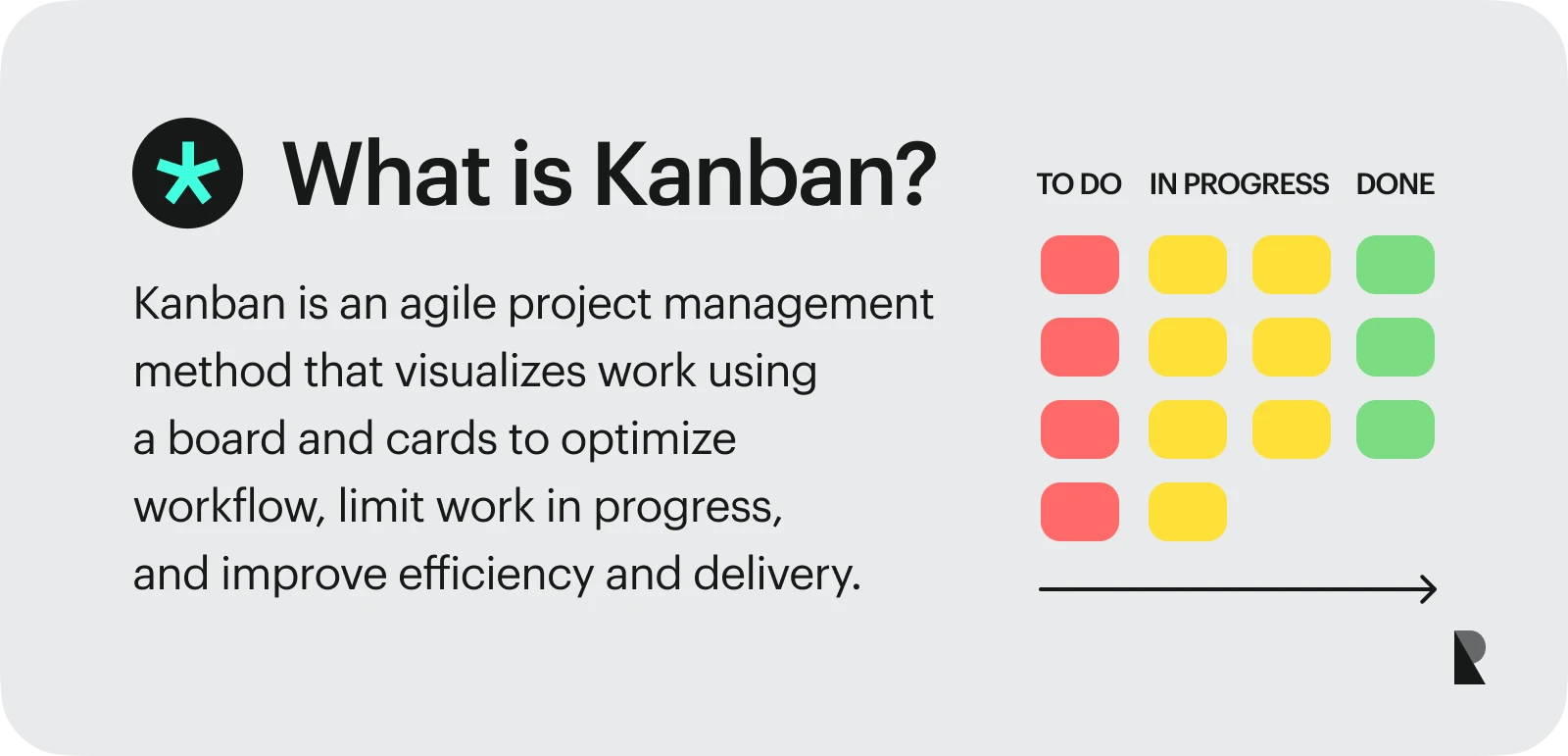
Kanban is a system designed to visualize and optimize the flow of work. Originating from Toyota's lean manufacturing practices, it focuses on creating a clear picture of what tasks are in progress, what’s waiting, and what’s completed. The heart of the Kanban method is the board, divided into columns representing workflow stages. Tasks move from one column to the next until they’re finished, making it easy to see progress from start to finish.
Kanban’s strength lies in its adaptability. There are no fixed roles or rigid timeframes — instead, the framework emphasizes flexibility, visibility, and continuous improvement. Teams can use Kanban boards to manage priorities, balance workloads, and react quickly when circumstances change.
Principles of Kanban
The framework is built around a few simple yet powerful principles. Teams should visualize the flow of work, limit the number of tasks in progress at any given time, and manage work items based on demand and capacity. Progress WIP — determining how many tasks are active simultaneously — is a central concept, as it prevents overload and highlights bottlenecks. The ultimate aim is to improve workflow and create steady, predictable delivery.
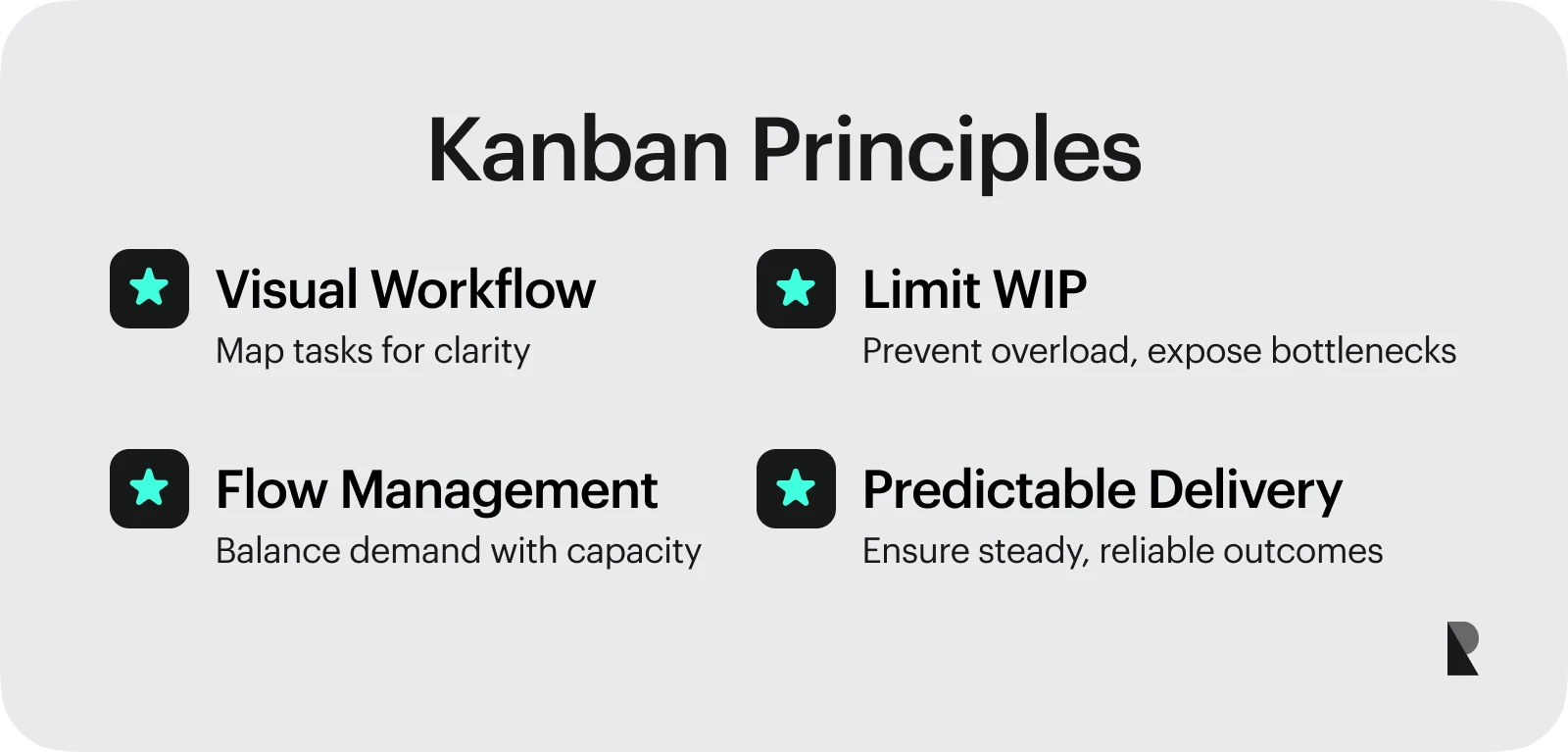
Metrics and KPIs in Kanban
Measuring performance is essential for Kanban to work effectively. Three standard metrics stand out: lead time, cycle time, and throughput.
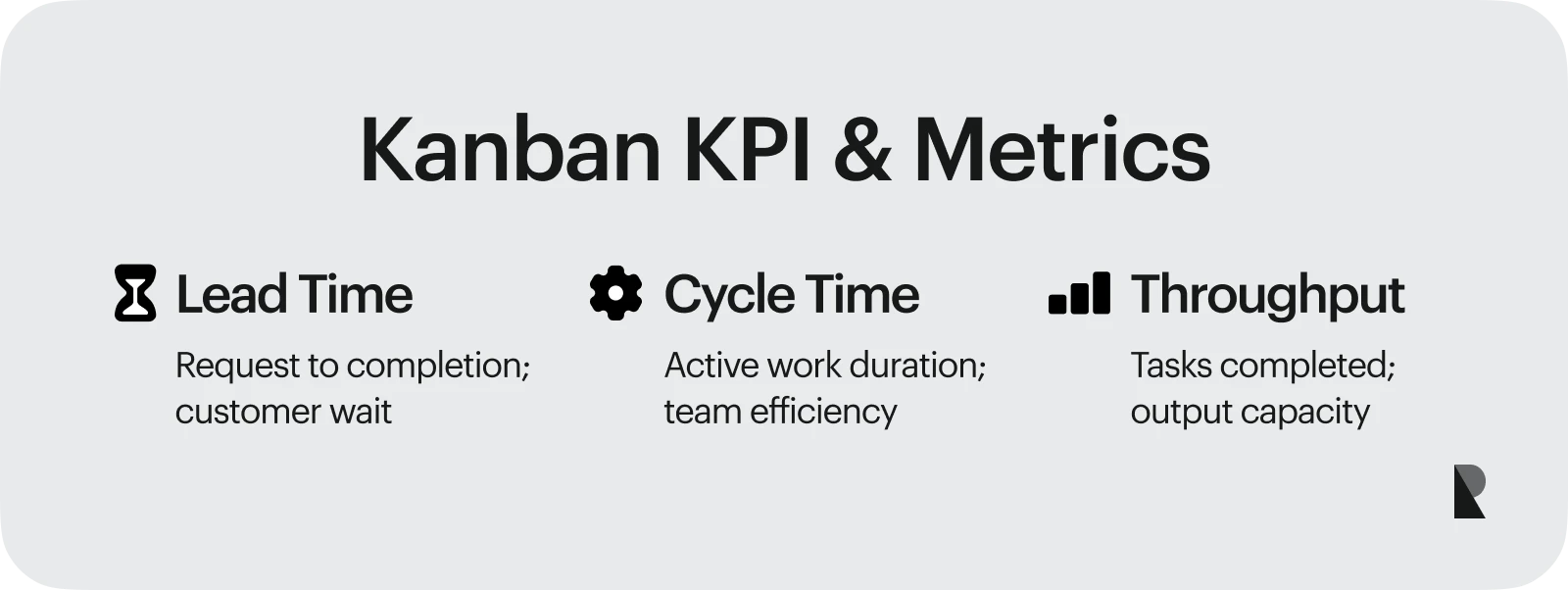
Lead time tracks how long it takes for a task to move from request to completion, giving a sense of the customer’s wait time. Cycle time focuses on the amount of time a task spends actively in progress, offering a clearer view of team efficiency. Throughput measures how many tasks are completed within a given period, making it easier to assess output and capacity. These metrics allow managers to identify trends, improve workflow, and predict how quickly future work will be delivered.
Pros of Kanban
Kanban offers several advantages to teams seeking agility without heavy structure. Its flexibility means it adapts easily to different project environments. Transparency is another key benefit — with everything displayed on the Kanban board, it’s easy to see what each team member is working on and where tasks may be stuck.
The simplicity of setup makes Kanban accessible. A team can start with nothing more than sticky notes and a whiteboard, or use digital Kanban boards for distributed teams. Because it doesn’t require defined roles or strict ceremonies, adoption is quick, and organizations can begin seeing improvements almost immediately.
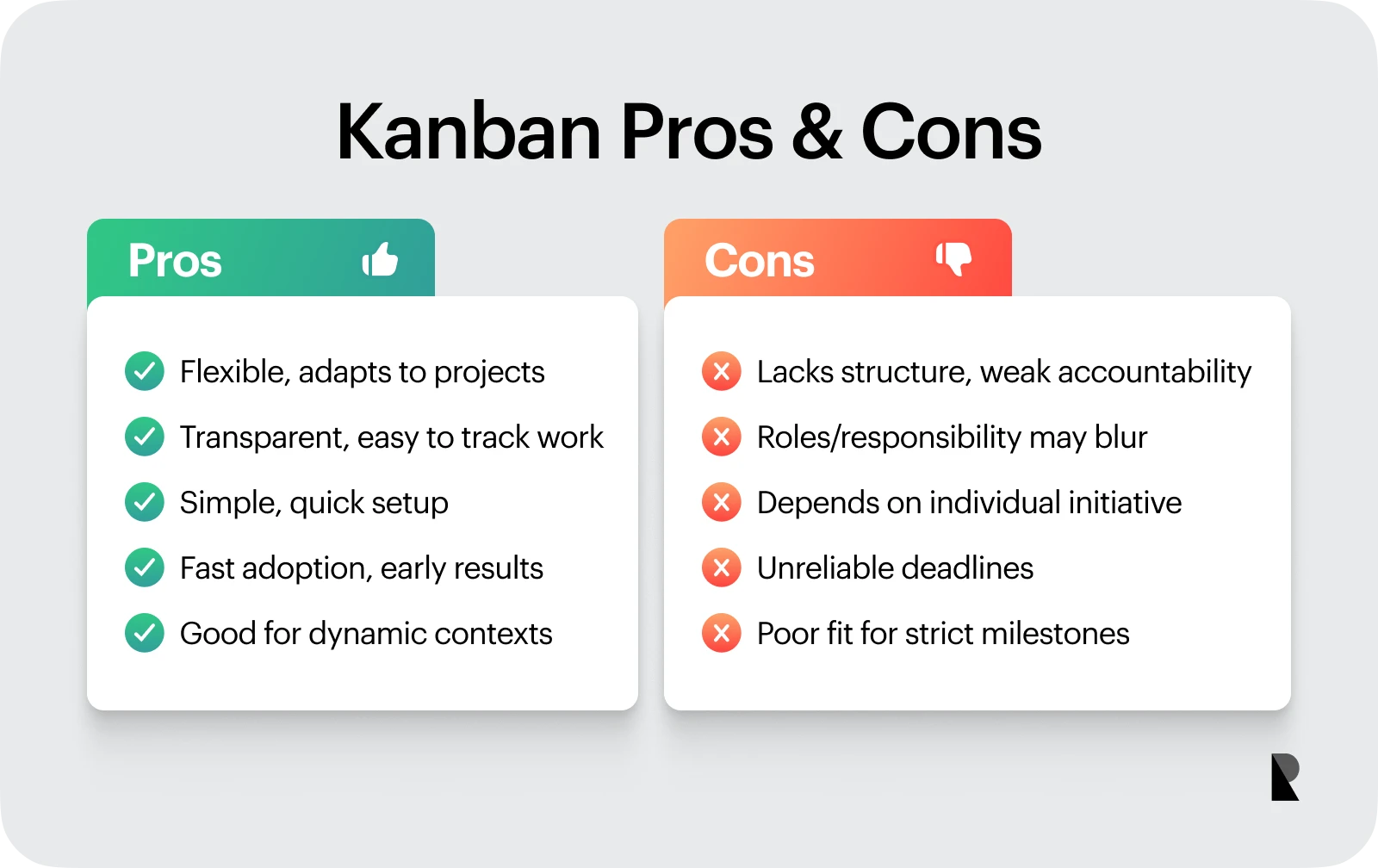
Cons of Kanban
Despite its advantages, Kanban has limitations. One challenge is the lack of structure, making creating accountability in larger teams harder. Without clearly defined roles, responsibility may blur, and outcomes could depend heavily on individual initiative.
Another limitation is deadline predictability. While cycle time and throughput provide valuable insights, Kanban doesn’t always guarantee fixed delivery dates, especially in fast-changing environments. For projects that require strict milestones or regulated processes, this can create friction.
What is Scrum?
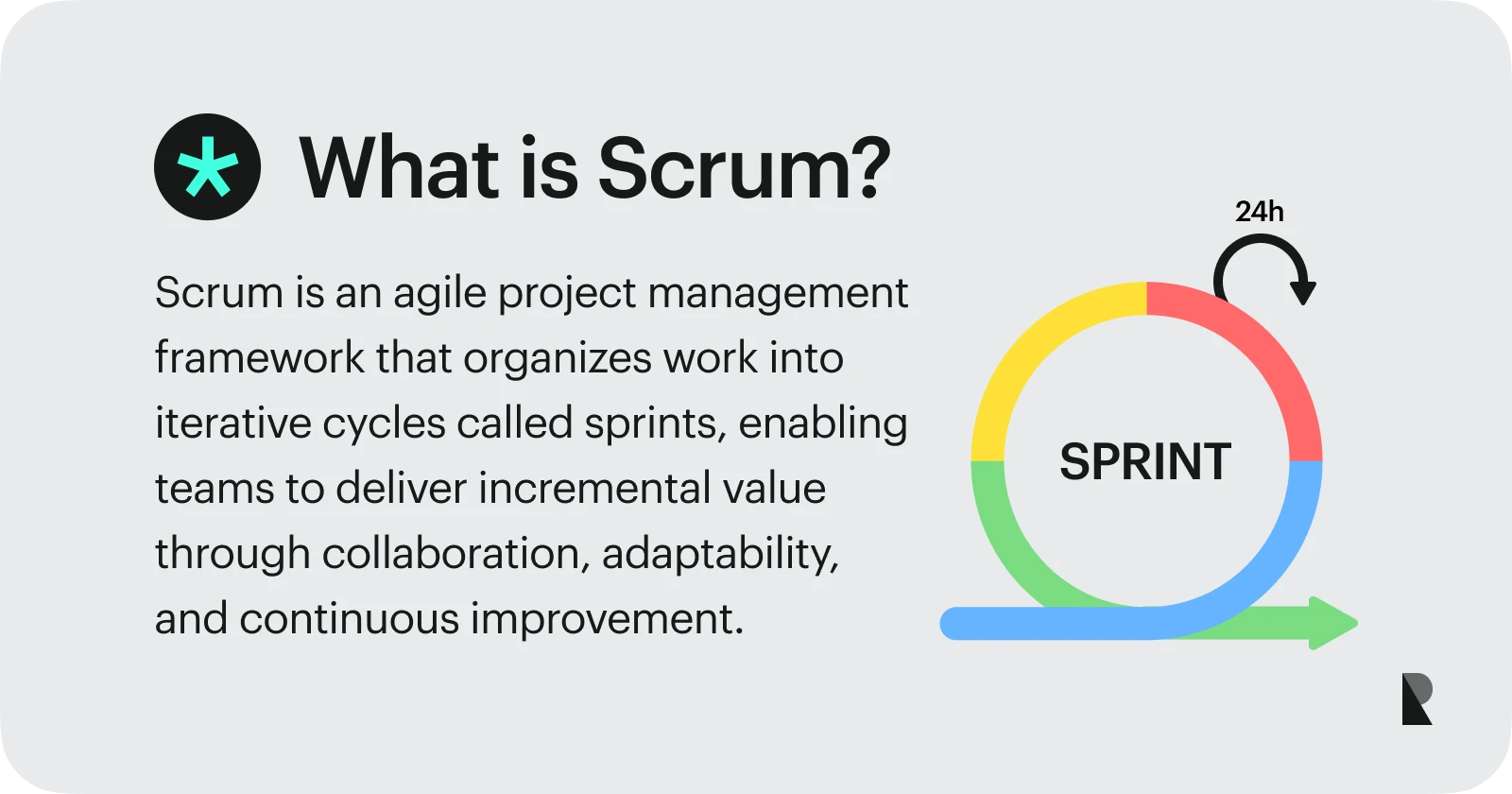
Scrum takes a more structured approach to Agile project management. It organizes work into fixed-length sprints, usually lasting two to four weeks. At the end of each sprint, the development team delivers a potentially shippable product increment. This rhythm creates regular checkpoints for reviewing progress and adapting plans.
Scrum is built on defined roles. The product owner manages the product backlog and sets priorities. The Scrum Master facilitates collaboration, removes obstacles, and safeguards the process. Scrum teams — small, cross-functional groups — handle the actual work of design, development, and testing. Together, these roles create a structured environment where responsibility is clearly distributed.
Scrum’s principles revolve around iterative progress, transparency, and accountability. By working in short cycles, teams can adjust quickly to change while delivering tangible results.
Metrics and KPIs in Scrum
Scrum uses its own set of metrics to track progress and efficiency. Velocity measures how much work a team completes in a sprint, providing insight into future planning. Burndown charts visualize remaining work against time, helping teams stay on track and adjust. Sprint goals define the primary objectives of each cycle, giving the team a shared focus and ensuring progress is aligned with business value.
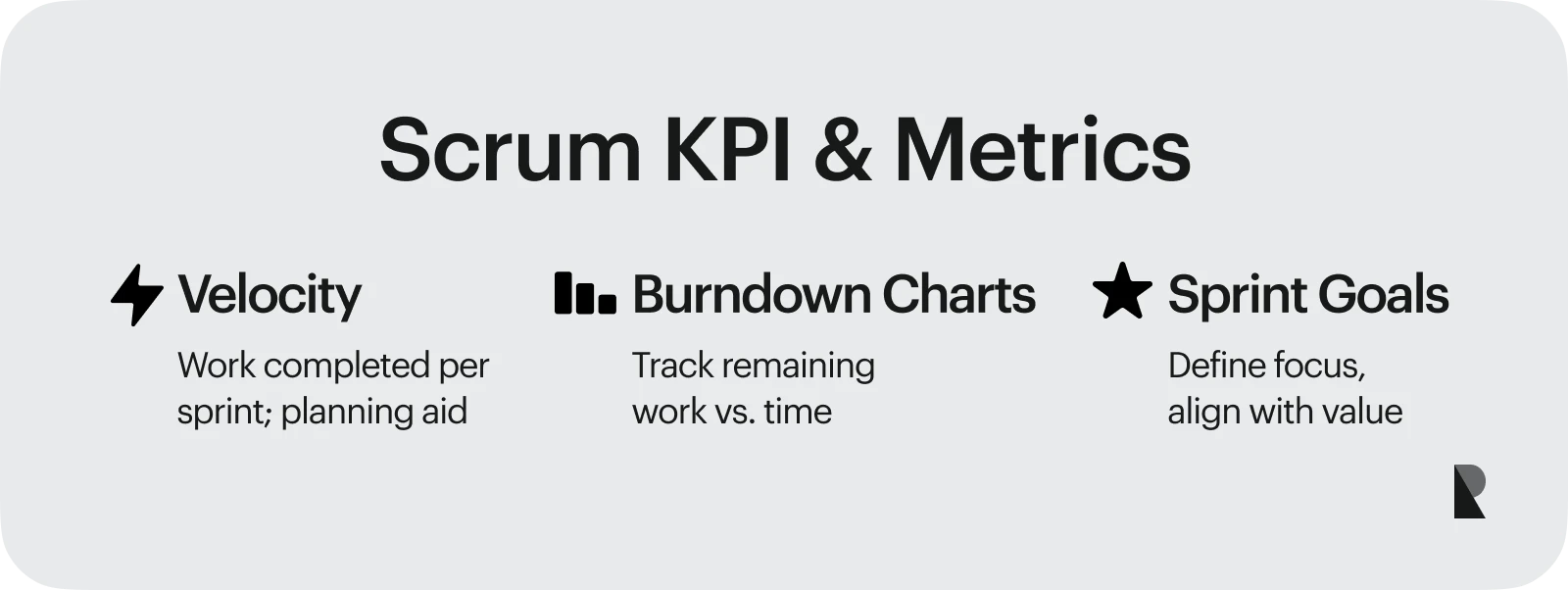
These metrics create clarity. They show whether the team is improving, where bottlenecks exist, and how realistic future commitments are.
Pros of Scrum
Scrum offers substantial benefits for teams that thrive on collaboration and accountability. The structured rhythm of sprints encourages everyone to participate actively and creates a sense of shared responsibility. Predictable results are another advantage — since each sprint ends with a potentially shippable increment, stakeholders have regular visibility into progress.
Scrum’s customer focus is also notable. By maintaining a prioritized product backlog, the framework makes sure the most valuable features are addressed first. This approach keeps work aligned with real user needs and prevents wasted effort.
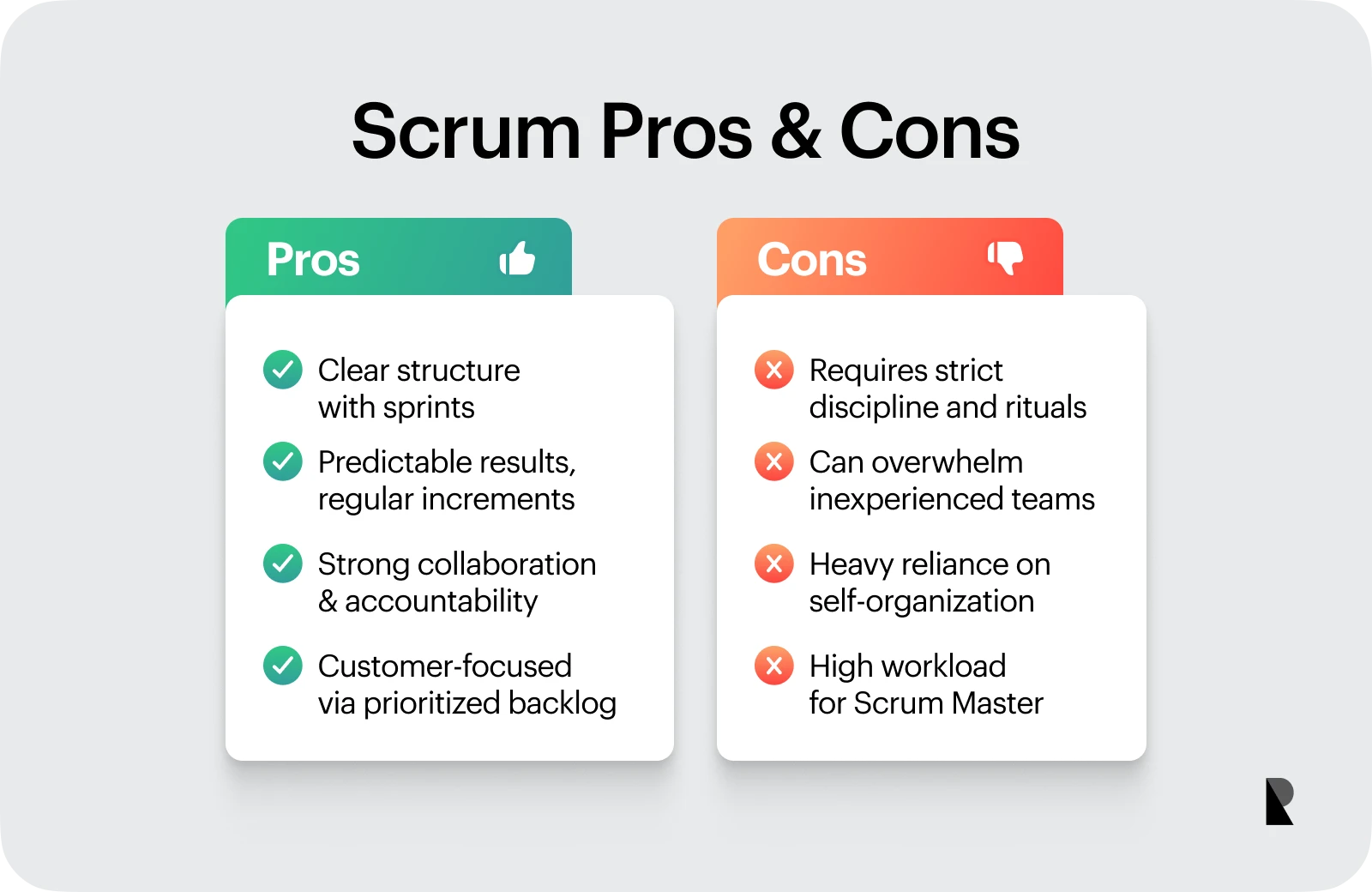
Cons of Scrum
Scrum’s structure also comes with demands. The framework requires strict discipline, with daily stand-ups, sprint reviews, and retrospectives. Teams must be committed to these rituals for Scrum to deliver its full benefits.
Another challenge lies in team maturity. Scrum depends on a high level of self-organization, communication, and trust. If a team lacks experience, the framework can feel overwhelming. The workload for the Scrum Master is also significant, as they must balance coaching, conflict resolution, and process facilitation.
Kanban vs Scrum: Key Differences
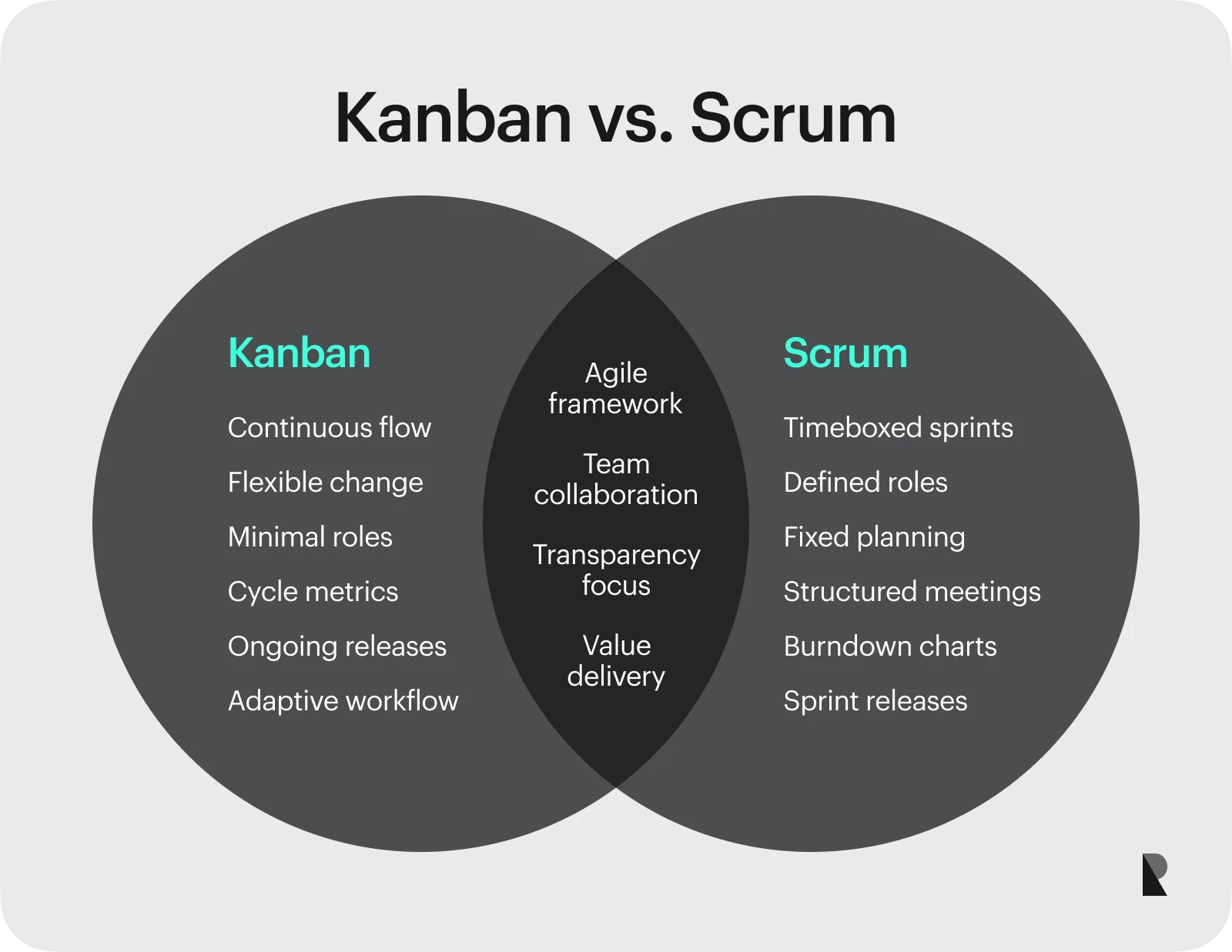
Both frameworks share an Agile foundation, but their execution is very different. Choosing between Kanban vs Scrum often depends on how a team prefers to plan, manage accountability, and track progress. There’s no single best option: Scrum works particularly well when rapid delivery is critical, while Kanban shines for more minor, incremental improvements.
Roles and accountabilities
This is where the contrast becomes clear. Kanban operates with minimal role definitions — anyone on the team can pick up tasks from the board, and accountability emerges through collective ownership. Scrum, in contrast, requires defined roles. The product owner, Scrum Master, and development team each carry specific responsibilities that structure the workflow.
Defining roles can add clarity and increase the need for training and role alignment. Kanban’s looser structure may be easier to adopt quickly, though it sometimes risks confusion when teams grow.
Planning and work commitment
Scrum thrives on planning. Each sprint begins with a planning meeting, during which the team commits to a set of tasks from the product backlog. This creates a clear roadmap for the next two to four weeks. Kanban, on the other hand, works on continuous flow. Teams pull new work items whenever capacity allows, without waiting for a fixed cycle.
This difference makes Scrum useful when deadlines or milestones matter, while Kanban works best when work is ongoing and less predictable.
Meetings and cadence
Scrum requires many get-togethers: sprint planning, daily stand-ups, sprint reviews, and retrospectives. These meetings create structure and rhythm but also add time commitments. Kanban is lighter — meetings are optional and held mostly when needed to improve workflow.
The balance between structured rituals and ad hoc collaboration often determines which framework is a better cultural fit for a team.
Boards: Kanban board vs Scrum board
Kanban and Scrum rely on boards, but how they’re used sets them apart. A Kanban board is designed to show the entire workflow from start to finish. Each task is represented as a card that moves across columns like “To Do,” “In Progress,” and “Done.” Because the board is continuous, it reflects the ongoing nature of work. Teams use Kanban boards to visualize bottlenecks, limit work in progress, and maintain a smooth flow of work.
Scrum boards reset with each sprint. They display the tasks selected during sprint planning, and once the sprint ends, the board is cleared. This creates a sense of momentum and provides teams with regular checkpoints for progress. Scrum boards reinforce the idea of timeboxed work, while Kanban boards highlight continuity and adaptability.
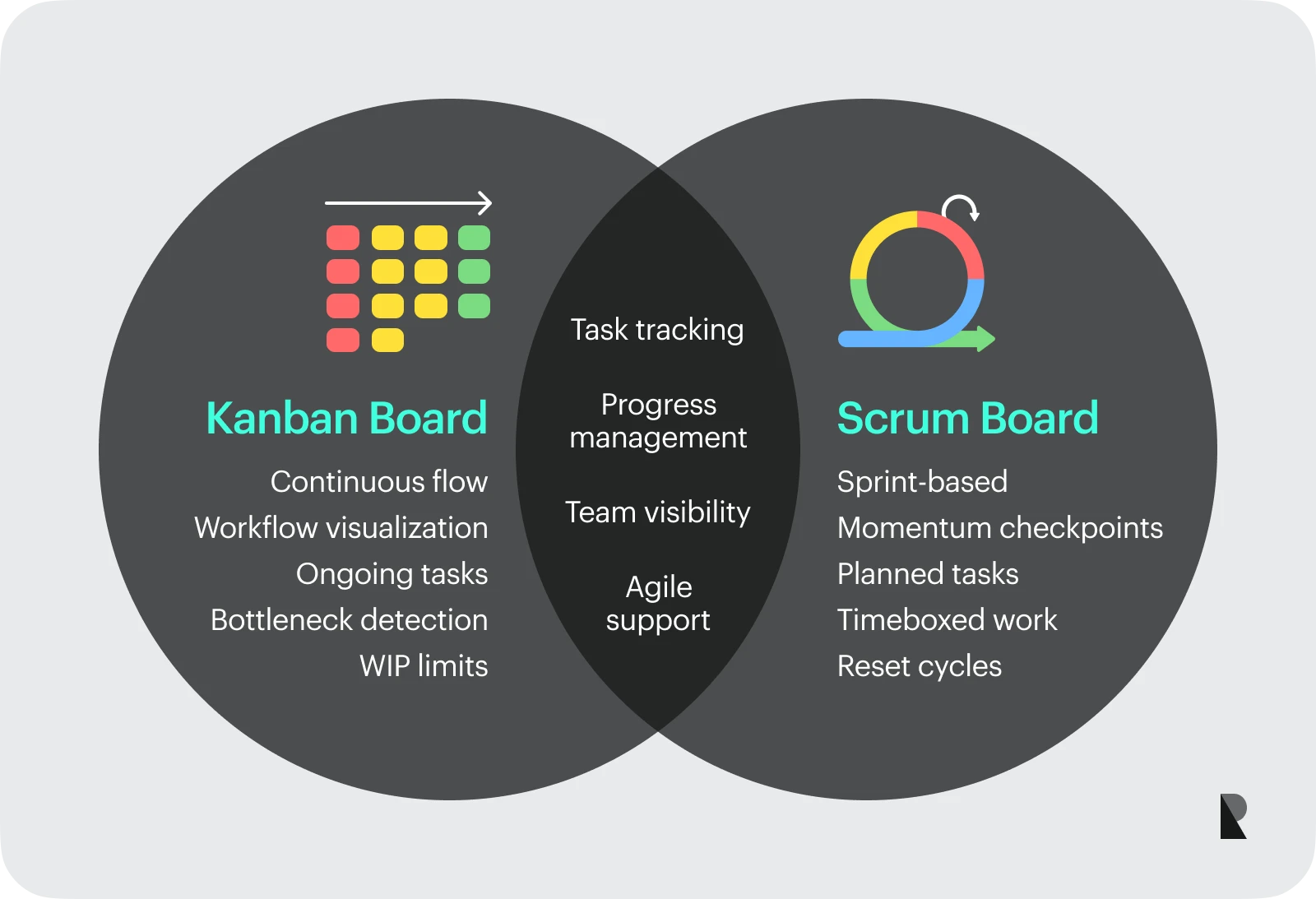
Release methodology
The release philosophy of the two approaches differs. Kanban allows releases at any point (when a task is complete, it can be delivered). This is especially useful in environments where speed matters or where updates are small and frequent. Teams can use Kanban boards to track which items are ready for release without waiting for a cycle to end.
Scrum, however, schedules releases at the end of each sprint. By bundling increments together, Scrum provides predictability and makes it easier for stakeholders to review progress in meaningful chunks. This sprint-end release cycle creates rhythm, but also means waiting for an item to be finished early.
Flexibility and change philosophy
Another difference lies in how change is handled. Kanban embraces ongoing adaptability. Teams can reprioritize tasks and adjust the workflow as needed without disrupting the system. This makes Kanban effective in operations, IT support, or service environments where priorities shift quickly.
Scrum is stricter. Once a sprint begins, the commitment is fixed. This creates focus and stability, but it also means urgent changes may need to wait. The sprint structure protects teams from constant shifting but can feel rigid in volatile contexts.
Estimating and measuring work
Scrum emphasizes estimation. Teams often use story points to size tasks and velocity to measure how much work they complete in each sprint. This helps with planning and forecasting future capacity. Burndown charts add another layer of visibility by tracking progress against the sprint goal.
Kanban focuses less on estimation and more on measurement. Metrics such as cycle time and throughput show how quickly tasks move through the system and how much work is delivered. Instead of predicting what can be achieved, Kanban evaluates actual performance and adapts based on results.
Kanban vs. Scrum: Similarities
Despite their differences, Kanban and Scrum share more than many realize. Both belong to the Agile family of methodologies, and both aim to improve collaboration, increase transparency, and deliver customer value.
Shared agile foundations
The Agile principles that guide both frameworks emphasize iteration, adaptability, and teamwork. Whether a team chooses Scrum or Kanban, the end goal is the same: to build products and services that respond to customer needs while maintaining efficiency. Both encourage breaking work into smaller pieces, reflecting often, and adjusting strategies.
Transparency and continuous improvement
Transparency is a shared value: Scrum achieves it through regular meetings and clear role definitions, while Kanban relies on visible boards and workflow metrics. Both approaches also drive continuous improvement, where Scrum retrospectives encourage teams to reflect at the end of each sprint, and Kanban promotes ongoing workflow refinement. In either case, teams are motivated to identify what works well and what can be improved.
When to Use Kanban vs Scrum?
Choosing between Kanban and Scrum depends on the type of project, the team's maturity, and the organization's broader goals. Neither framework is universally better — what matters is the fit.
When Kanban works best
Kanban works best when work is continuous and priorities may shift rapidly. Its adaptability benefits IT support teams, service desks, and maintenance operations. With no sprint boundaries, teams can handle incoming requests without disrupting an existing plan. Kanban boards make it easy to track progress and balance workloads, while the use of metrics like cycle time helps maintain efficiency.
Kanban is also valuable when teams need a lightweight approach. Adopting is faster and less disruptive because it doesn’t require defined roles or fixed ceremonies. Organizations that need to introduce agility gradually often find it easier to start with Kanban.
When Scrum works best
Scrum works best for product development projects that thrive on structure and iteration. The sprint rhythm provides a predictable cadence that stakeholders can rely on. Defined roles — product owner, Scrum Master, and development team — create accountability and support cross-functional collaboration.
Scrum is especially effective when innovation is needed. By organizing work into sprints, teams can experiment, receive feedback, and adjust quickly. The product backlog ensures that priorities are clear and aligned with business goals. Scrum’s planning and commitment model can be highly effective for organizations that value predictability.
Hybrid approach: Scrumban
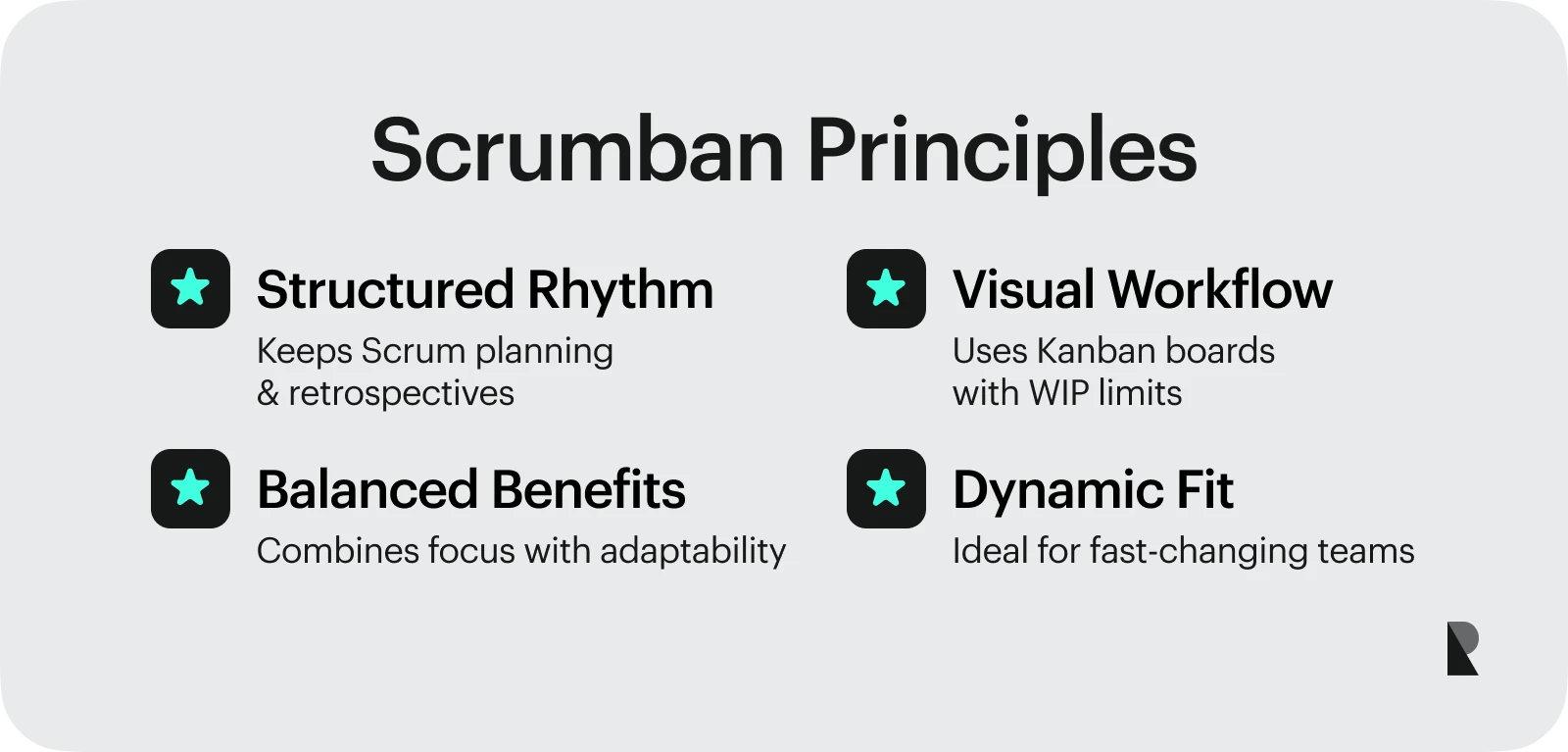
Some organizations find that a blend of both frameworks works best. Scrumban combines the structure of Scrum with the flexibility of Kanban. For example, teams may keep sprint planning and retrospectives but manage work on a Kanban board with progress WIP limits.
This hybrid approach benefits teams from Scrum’s role clarity and rhythm while gaining Kanban’s adaptability. It benefits dynamic teams needing focus and flexibility, such as startups balancing product development with ongoing operational tasks.
Conclusion
Agile project management thrives on adaptability. Kanban and Scrum remain the two most powerful frameworks. Kanban offers flexibility and continuous flow, which are ideal for evolving workloads and service-driven teams. Scrum brings structure, predictability, and team engagement, which suits product development and innovation.
The debate of Kanban vs Scrum is less about which is superior and more about which matches your team’s culture and goals. Some find clarity in Scrum’s discipline, others value the freedom of Kanban, and many succeed by blending both into a hybrid Scrumban approach. The most brilliant move is to choose the framework that fits your reality today — and stay open to evolving it tomorrow.
Partnering with a brand design agency can help align methodology with broader business strategy, while collaborating with a software development company can provide the technical expertise needed to implement Agile principles.
Oct 1, 2025
